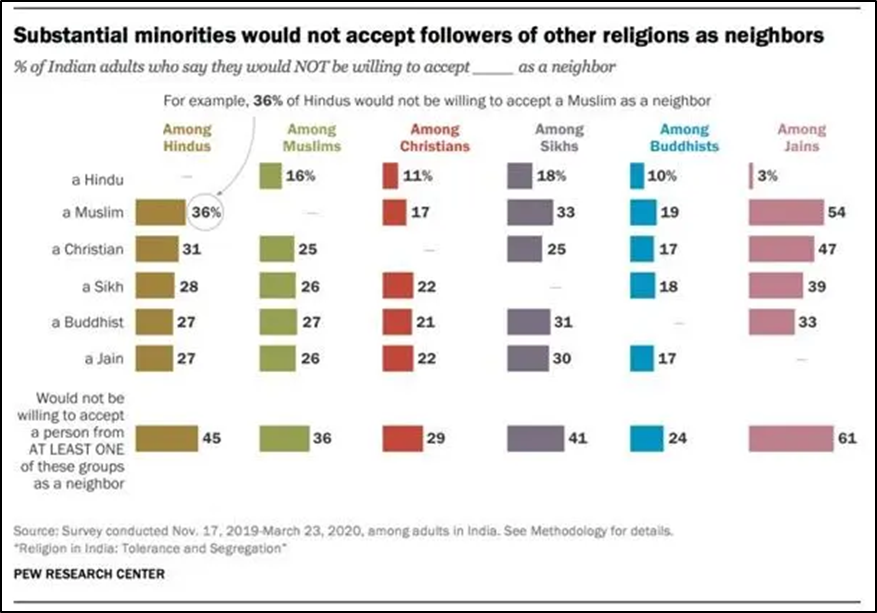Context-
As per the National Family Health Survey, Residential segregation of Muslims in India has profound implications on their access to quality education and health services, further compounded by their low representation in influential positions. This community's socio-economic disadvantages are deep-rooted and persistent, hindering their overall progress and integration into mainstream society.
Educational Disparities
- Lower Educational Attainment : Statistics from the 2019-21 National Family Health Survey reveal significant educational disparities. The median years of completed schooling for a male household head in the Muslim community is almost two years lower than the national average. This educational gap indicates a significant barrier to accessing better job opportunities and improving socio-economic status.
- Limited Access to Quality Education : Residential segregation limits access to good schools and educational institutions. Contrary to the perception that Muslims prefer religious education, the Sachar Committee report (2006) noted that only 3% of Muslim children attend madrasas for primary education. Many Muslim children are enrolled in Maktabs, providing supplementary religious education and public schooling. The prevalence of madrasas is often a response to the lack of mainstream and quality schooling due to segregation.
- Gender Gap in Education : The gender gap in educational attainment within the Muslim community is notable, with a significant drop in overall educational levels at the tertiary stage. This gap contributes to higher fertility rates among Muslims, a marker of poor education rather than prosperity. The cultural norm of not educating Muslim girls beyond middle and high school is reinforced in segregated communities, perpetuating the cycle of low educational attainment and limited opportunities.
Health Disparities
- Higher Infant Mortality and Malnutrition Rates : Health indicators for Muslims are similarly troubling. Urban infant mortality rates among Muslims are almost 5% higher than the national average, and a higher percentage of children under five are malnourished compared to their peers. These health disparities are linked to socio-economic disadvantages and limited access to quality health services, exacerbated by residential segregation.
Residential Segregation and Its Implications
- Segregation and Public Goods Consumption : Residential segregation of Muslims is symptomatic of their socio-economic underdevelopment. Discrimination in urban rental housing and land markets leads to ghettoization, making minority communities easier targets during communal violence and limiting their access to public goods and services. Studies using SECC and Census data from 3,000 cities in 2012-13 document that cities with larger Muslim populations have worse access to public health and education. Within cities, segregated Muslim neighborhoods consume fewer public goods, further entrenching their disadvantages.

- Ghettoization and Socio-Economic Mobility : Race-based residential segregation has been extensively studied in the US, providing robust evidence that such segregation hinders upward socio-economic mobility, particularly for the Black population. Similarly, the ghettoization of Muslims in urban India restricts their socio-economic development and maintains their marginalized status. Identity-based segregation relegates Muslims to the fringes of urban life, limiting their opportunities and perpetuating poverty.
- Public Sector Representation : Muslims are significantly underrepresented in the public sector. The Sachar Report highlighted that Muslims have constituted only 3-6% of IAS and IPS officers, district judges, or judicial officers for decades. This invisibility in the public sector is accompanied by inadequate political representation. Since Independence, only 4-9% of MPs in the Lok Sabha have been Muslims, despite the community making up 14% of India’s population.
Policy Solutions and Recommendations
- Desegregation and Integration Policies : Achieving desegregation and integration is challenging, as evidenced by the US experience. However, effective policy experiments in other contexts, such as Singapore's Ethnic Integration Policy, offer potential solutions. In Singapore, 80% of the population resides in public housing with quotas ensuring a balanced ethnic mix. Similar policies in India could influence bank loans and the sale of public land to housing developers and cooperative housing societies, promoting desegregation without legal mandates.
- Affirmative Action and Economic Criteria : Policies should incorporate economic status as a criterion for receiving state benefits. Affirmative action in employment, education, and housing, considering economic disadvantage through the EWS category, can address systemic cultural biases against disadvantaged groups. Integrating families from different communities can foster tolerance and cohesion, as children attending the same schools and playing together build strong bonds.
Conclusion
Residential segregation and its resultant constraints on accessing quality education and health services, along with low representation in positions of influence, continue to marginalize India’s Muslim community. Addressing these deep-rooted disparities requires comprehensive policy interventions focused on desegregation, affirmative action, and economic criteria. Only by ensuring equitable access to opportunities and resources can India progress collectively, including the 14% of its population that is Muslim.
|
Probable Questions for UPSC Mains Exam-
|
Source- The Indian Express







